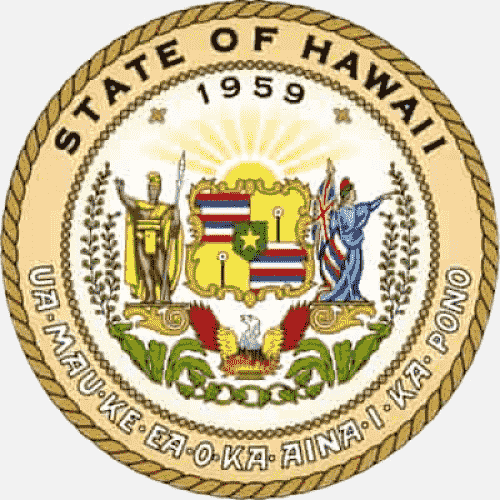 State Flag |  State Seal |
Hawaii is the 50th and most recent U.S. state to join the United States. It joined the Union on August 21, 1959. It is the only U.S. state located in Oceania and the only one made up entirely of islands. There are no separately incorporated cities in the entire state; Honolulu is both a city and county.
- ABBREVIATION: HI
- NICKNAME: The Aloha State
- POPULATION: 1,446,146 (2024 est.)
- CAPITAL: Honolulu
- STATE BIRD: Nene
- STATE FLOWER: Hibiscus
- AREA: 10,931 sq. mi.
- TIME ZONE: Hawaii: UTC −10 (no DST)
- ENTERED UNION: Aug. 21, 1959
- ALTITUDE: High, 13,796 ft. Mauna Kea
- CLIMATE: Great variation on rainfall depending on trade winds. Windward slopes are wet, leeward slopes generally dry. Mild temperatures.
“We came from Hawaiki-the-Great” runs the ancient Polynesian chant, “from Hawaiki-the-Long, from Hawaiki-the-Distant.” So sang these far-roving South Pacific peoples as they sailed eastward, populating Samoa, Tonga, Bora-Bora, Tahiti and the Marquesas as they went.
Sometime in the remote past, navigating by the stars in 70-foot double-hulled canoes, they came upon a vast island chain. They named the major island “Hawaiki”, as they had other islands at which they had passed on route. In time Hawaiki became Hawaii.
Here was an ocean paradise. Gradually created by volcanic action over millenniums, the eight main islands and a string of 20 coral-fringed islets sweep 1,600 miles across the Pacific. In their rich lava soil, the starchy taro plant flourished in the warm sun.

Hawaiian Islands from space
Hawaii’s strategic location in the mid-Pacific dominates its economy. A large part of its labor force is employed on well know military installations like the Navy’s Pearl Harbor. Agriculture has been a declining industry, for the plantation operators found that rising costs made it difficult to compete with continental U.S. and far eastern growers.
Fun Facts:
- More animals and plants native to Hawaii are on the endangered species list than in any other state. Even its state bird is endangered.
- There are only 12 letters in the Hawaiian alphabet: A, E, I, Q, U, H, K, L, M, N, P, and W.
- There are no racial or ethnic minorities in Hawaii. Everyone is a minority.
- You can ski two different ways on the same day in Hawaii: on water at the beach and on snow on the slopes of Mauna Kea, a 13,796 foot-high volcano on the big island.
- Mount Waialeale, on the island of Kauai, is the wettest place in the United States, with 460 inches of rainfall per year.
- Hawaii’s state fish is the Humuhumunukunukuakua’a, or trigger fish.
History:
The history of Hawaii is a unique and compelling story of Polynesian exploration, independent kingdom-building, Western contact, and eventual statehood. Its geographic isolation and cultural richness have given Hawaii a distinctive place in American and global history.
Long before Europeans arrived, Hawaii was settled by Polynesians who navigated thousands of miles across the Pacific Ocean in double-hulled canoes using the stars, ocean currents, and wind patterns.
The first settlers likely arrived between 300 and 800 CE from the Marquesas Islands, followed by later waves from Tahiti. These early Hawaiians developed a complex society with a rich oral tradition, a system of chiefs known as the ali‘i, and a religious and social structure called the kapu system.
Hawaiian society was deeply connected to nature, with agricultural innovations such as terraced taro farming and sophisticated fishponds. Over time, the islands became divided among competing chiefs, until the late 18th century, when King Kamehameha I unified the Hawaiian Islands through a series of battles, establishing the Kingdom of Hawaii in 1810.
Under his rule, Hawaii remained independent and entered into trade and diplomatic relations with foreign nations.
In 1778, British explorer Captain James Cook became the first European to visit Hawaii. His arrival marked the beginning of significant cultural change. After Cook’s death in Hawaii in 1779, increased contact with Westerners brought both opportunity and disruption.
Traders, missionaries, and whalers followed, introducing new technologies, religions, and diseases. The population of Native Hawaiians, once estimated at several hundred thousand, was devastated by foreign illnesses to which they had no immunity.
In the 19th century, American Christian missionaries had a strong influence, converting many Hawaiians to Christianity, introducing Western education, and promoting literacy through the Hawaiian language. Meanwhile, American and European businessmen established sugar and pineapple plantations, gaining economic and political power.
Kingdom governance evolved with a written constitution and increased interaction with the United States. However, tensions grew as foreign landowners sought greater control. In 1893, a group of American and European settlers, supported by the U.S. military, overthrew Queen Liliʻuokalani, the last reigning monarch of Hawaii. Despite her appeals to the U.S. government, the monarchy was never restored.
In 1898, Hawaii was annexed by the United States, and in 1900, it became a U.S. territory. During World War II, Hawaii’s strategic location made it a critical military base. The Japanese attack on Pearl Harbor on December 7, 1941, brought the U.S. into the war and forever linked Hawaii to a pivotal moment in world history.
After the war, the push for statehood grew stronger. On August 21, 1959, Hawaii became the 50th state of the United States—the only one composed entirely of islands and with a majority Asian and Pacific Islander population.
Today, Hawaii is known for its stunning natural beauty, multicultural society, and deep Indigenous roots. Its history reflects resilience, transformation, and the enduring spirit of its people. The legacy of the Hawaiian Kingdom and the voices of Native Hawaiians continue to shape Hawaii’s identity and future.